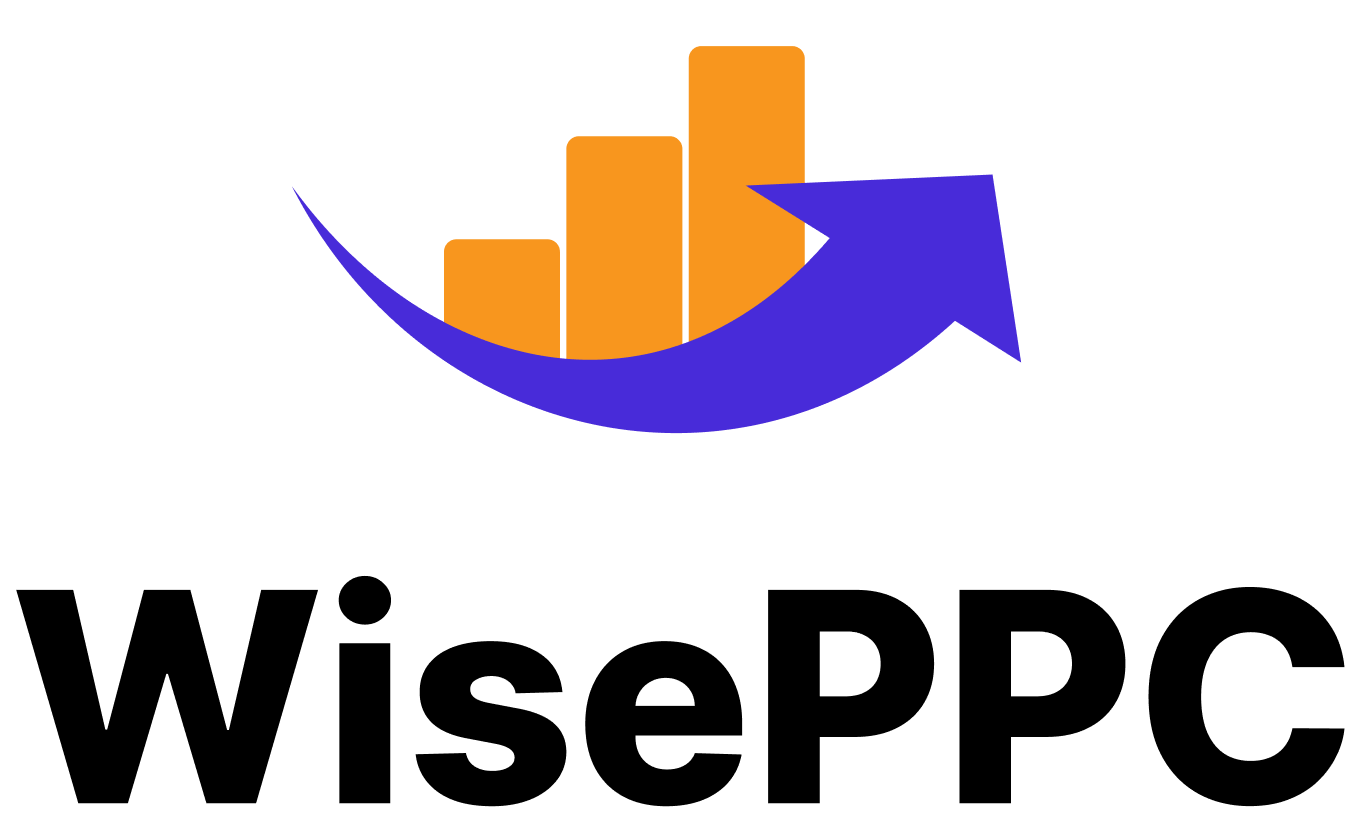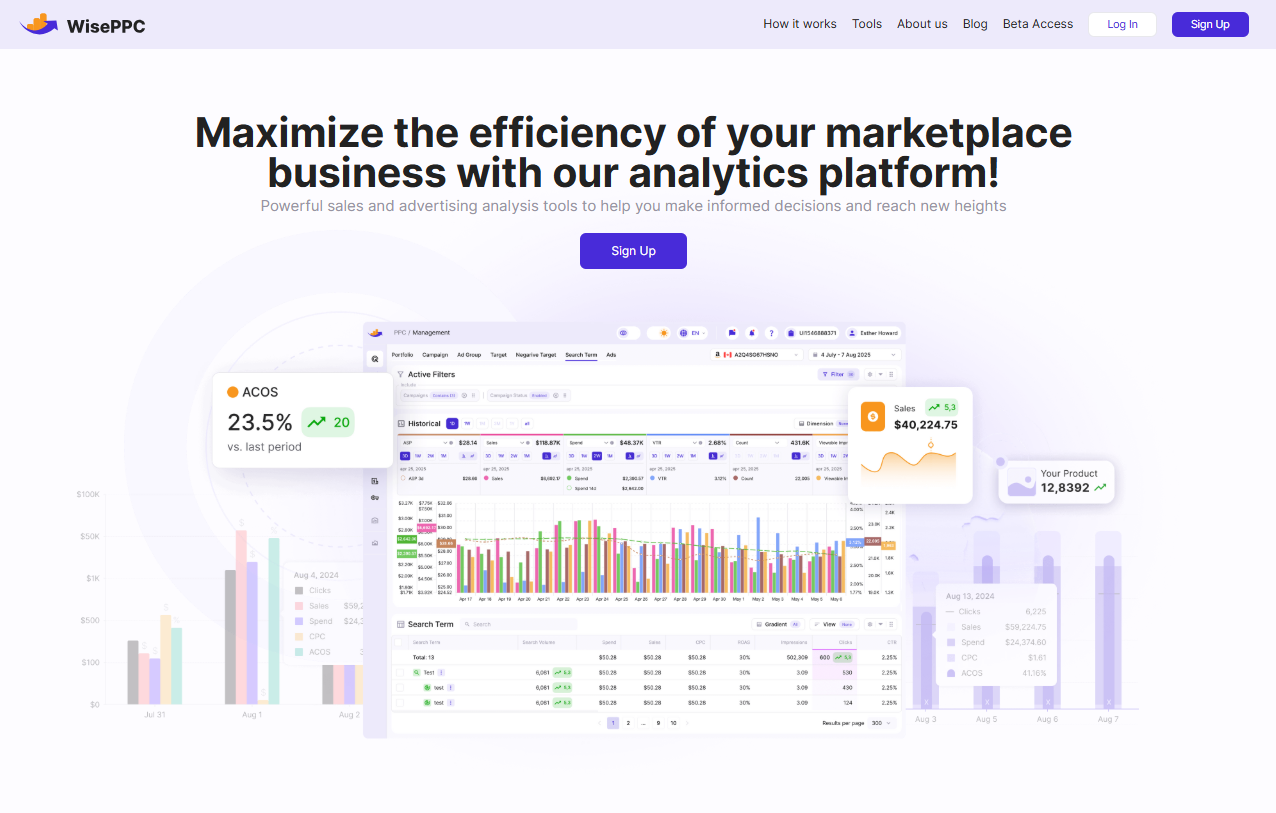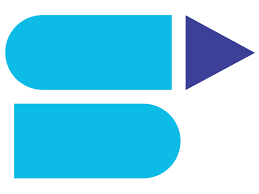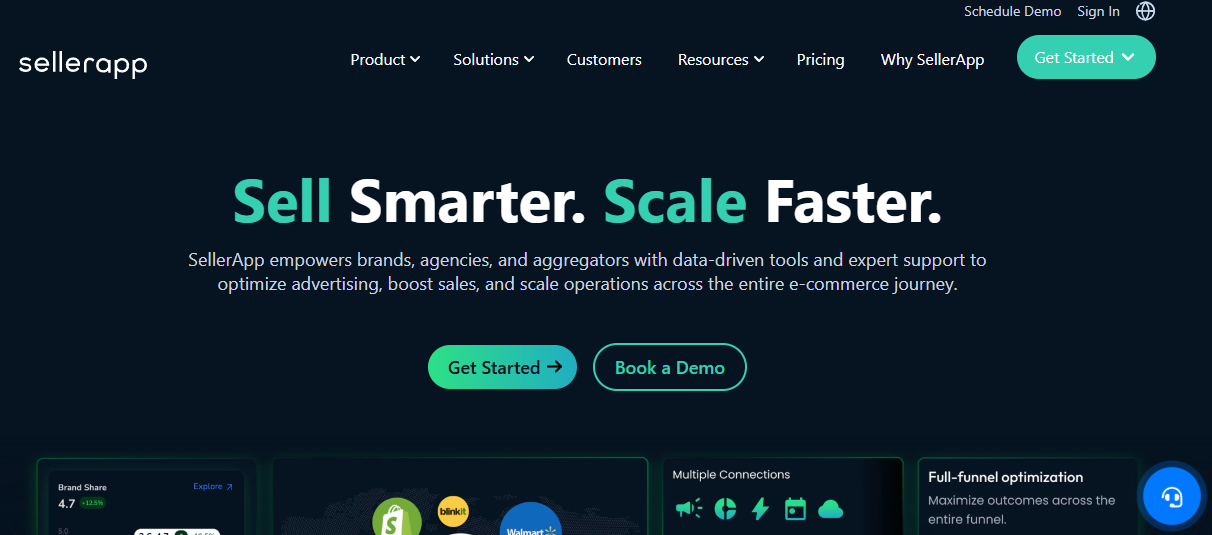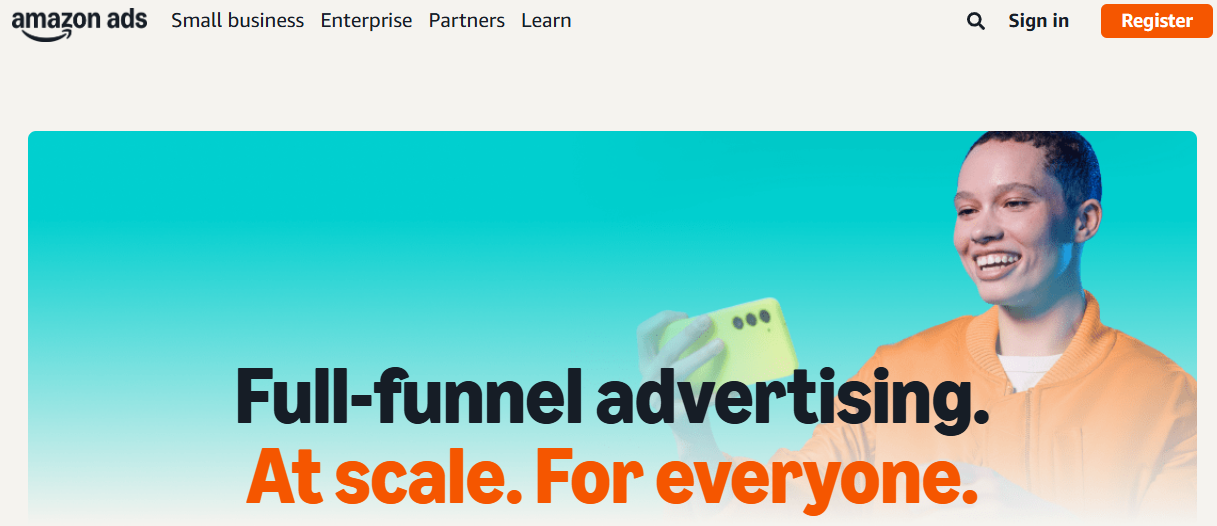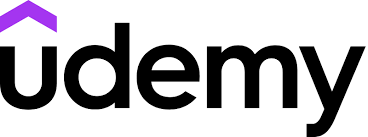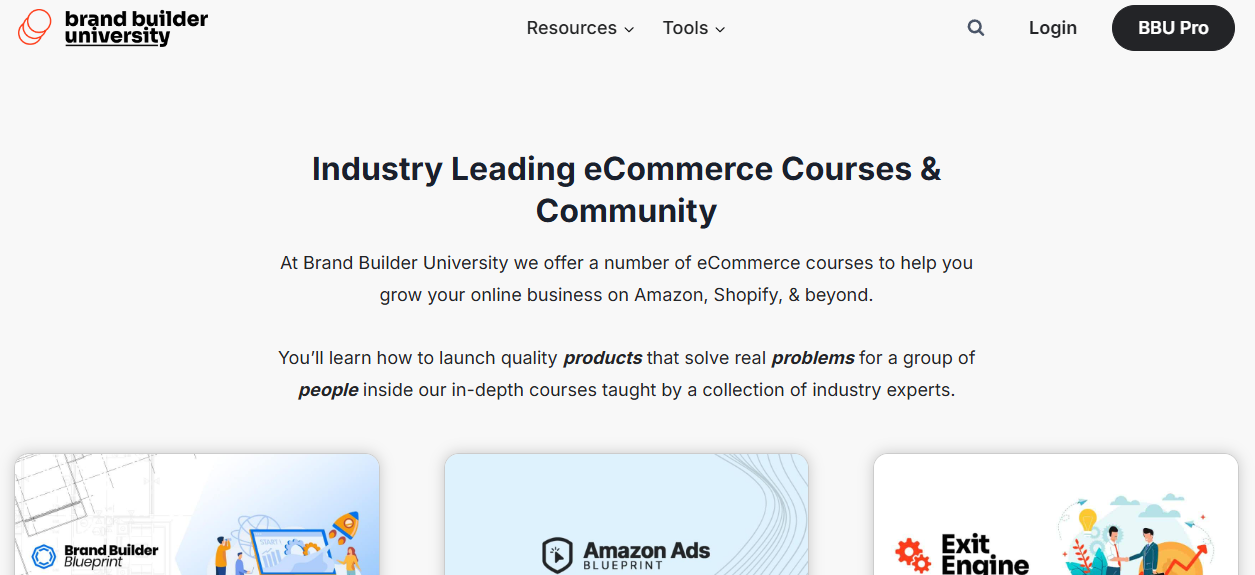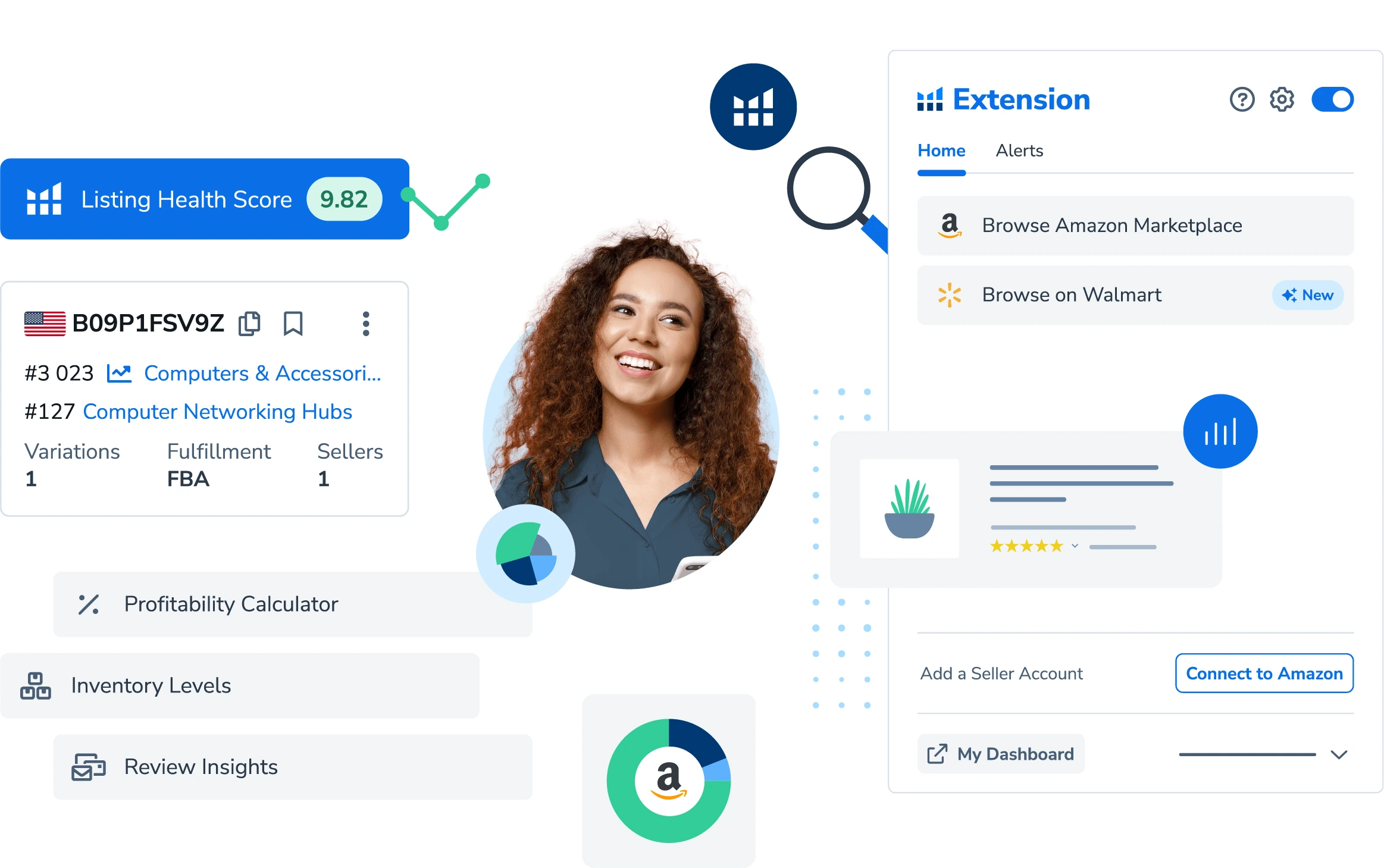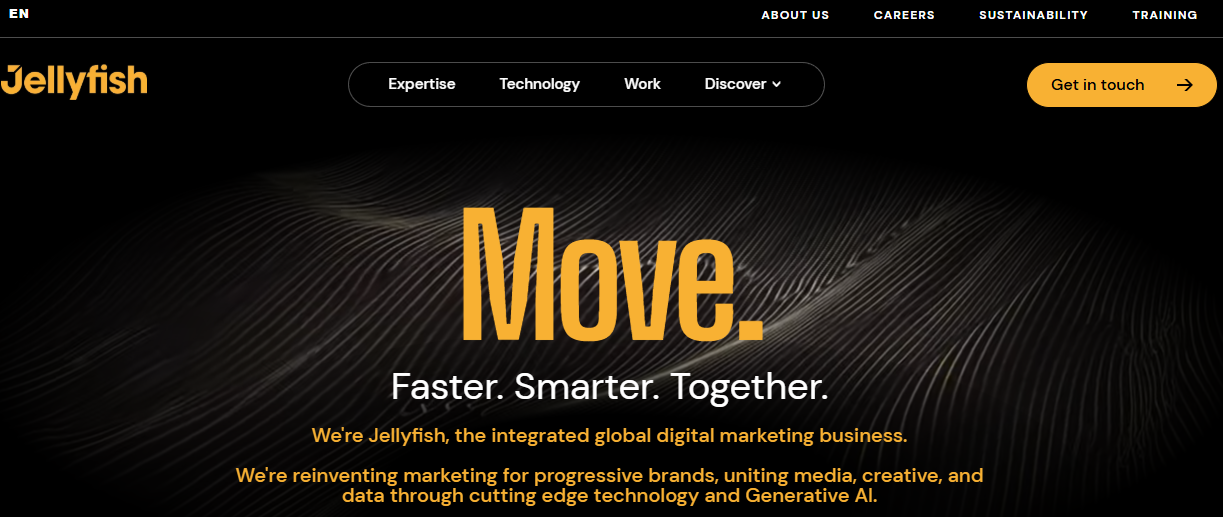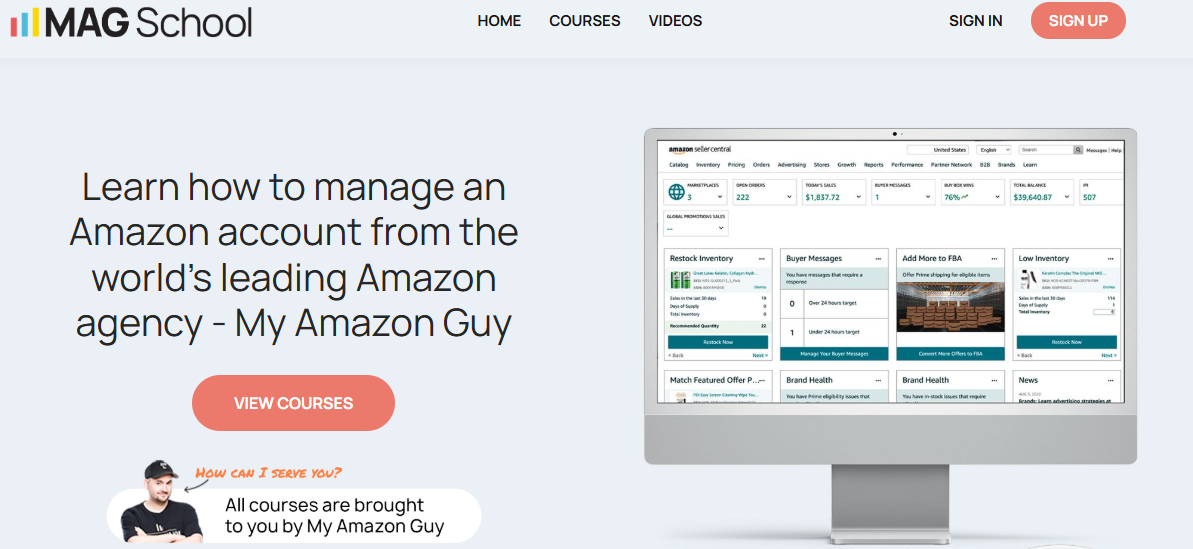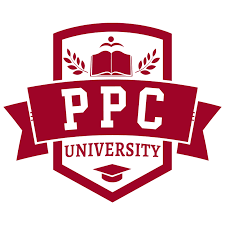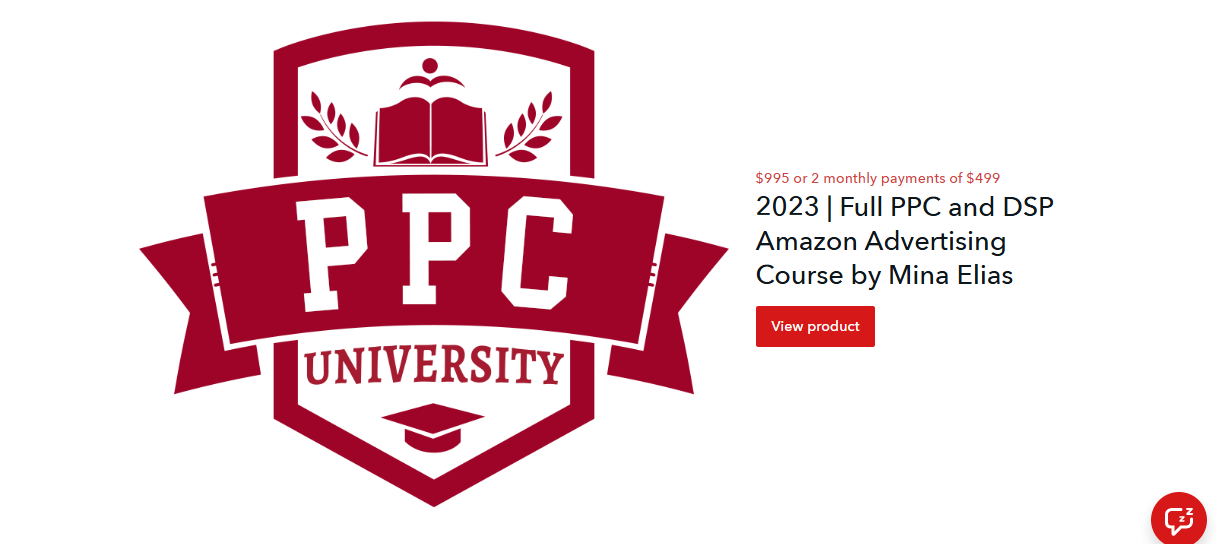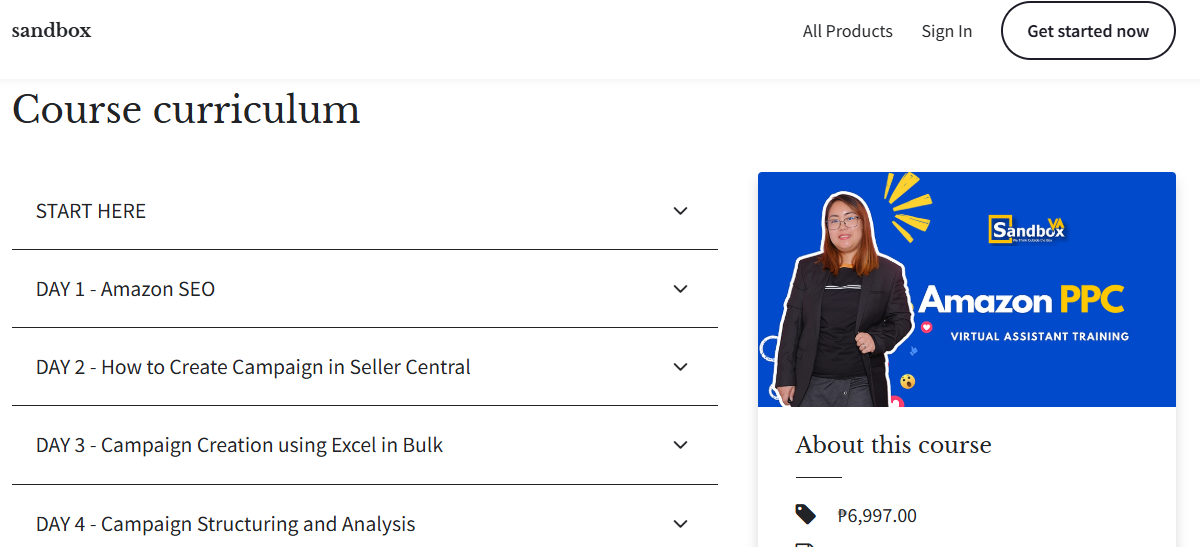Top Amazon PPC Courses That Don’t Waste Your Time
Learning Amazon PPC isn’t rocket science, but it’s easy to get overwhelmed by outdated tutorials and recycled advice. Whether you’re just starting out or trying to fine-tune your ad strategy, finding a course that actually teaches you something useful is half the battle. We’ve sifted through the noise to bring you PPC training that focuses on what matters, how to run ads that work, how to stop wasting money, and how to understand the numbers behind your results. This list isn’t about who shouts the loudest on YouTube. It’s for sellers who want to skip the hype and finally get a grip on what Amazon Ads are really doing behind the scenes.
WisePPC: Turning PPC Data Into Real Decisions
At WisePPC, we see Amazon advertising as more than just setting bids and hoping for results. Our platform is built to give sellers clarity around what’s driving performance and where money is being wasted. The platform connects directly with your marketplace data, so you don’t have to shuffle between spreadsheets or rely on short-term reports. With real-time tracking, filters, and campaign editing tools, we make it easier to spot what matters, act quickly, and keep campaigns on track without the noise.
Our platform also separates ad-driven revenue from organic sales, which helps sellers make smarter budget decisions. Instead of guessing where growth is coming from, you can see the full picture in one place. Whether you’re running ten products or managing a much larger catalog, our system is designed to scale with you. The goal isn’t to add more complexity, but to simplify PPC so you can focus on strategy, not firefighting.
1. Advanced Amazon PPC Bootcamp (Enablers)
Enablers runs an Advanced Amazon PPC Bootcamp that takes sellers through both the basics and more detailed aspects of advertising on Amazon. The program covers everything from campaign structures and keyword strategies to budget planning and reporting. Learners also work through listing optimization, ad placement analysis, and bulk sheet operations, with an emphasis on connecting PPC performance to conversion rates and sales outcomes.
The course goes further into topics like RUFUS AI ranking behavior, AI-driven competitor analysis, and external traffic attribution. Dayparting, long-term data tracking, and financial reporting are also part of the curriculum. The format is trainer-led and available both online and in person, giving participants a chance to apply strategies directly while having access to support when needed.
Key Highlights:
- Full pathway from PPC basics to advanced strategies
- Modules on listing audits, campaign setup, and keyword targeting
- Training on RUFUS AI search and competitor analysis with AI tools
- Practical focus on reporting, bid adjustments, and performance audits
- Hybrid delivery with online and face-to-face trainer support
Good Choice For:
- New and intermediate sellers wanting a structured program
- Sellers who want guidance on both ads and listing optimization
- Learners interested in applying advanced techniques like AI analysis
- Those who prefer trainer-led support in a hybrid setup
Contact Information:
- Website: www.enablers.org
- Phone: +9242 – 111 123 111
- Address: 43 – 44 / A, Civic Centre Block D 2 Phase 1 Johar Town, Lahore
- LinkedIn: www.linkedin.com/company/enablers-pakistan
- Facebook: www.facebook.com/EnablersTeam
- Instagram: www.instagram.com/enablers.official
- X (Twitter): x.com/enablers_org
2. Amazon PPC Setup & Things to Remember Before You Start (SellerApp)
SellerApp provides PPC learning through a blog-based course series, starting with campaign setup and covering essential areas like keyword match types, bidding, and budgeting. The material is designed to explain PPC in the context of Amazon’s competitive marketplace, helping sellers understand not just how ads are placed, but why budget alignment and clear objectives matter before launching campaigns.
The lessons illustrate concepts using simple examples, showing how ads influence visibility and how sales history improves organic rankings. SellerApp positions PPC as part of a cycle where ads not only bring traffic but also feed into long-term growth. The training is practical in tone, guiding sellers to balance advertising spend with realistic business goals.
Key Highlights:
- Blog-based course series with step-by-step lessons
- Focus on campaign setup, match types, and budgeting decisions
- Examples used to explain bidding and ad visibility
- Links PPC results with long-term ranking improvements
- Accessible material designed for newer sellers
Good Choice For:
- Beginners who prefer self-paced reading over formal classes
- Sellers starting their first PPC campaigns
- Those wanting to learn the basics before investing in advanced training
- Sellers looking to connect ads with long-term growth strategies
Contact Information:
- Website: www.sellerapp.com
- Phone: +1-737-225-3338
- Email: [email protected]
- Address: 4819 Bryant Mdws Dr, Spring, TX 77386, United States
- LinkedIn: www.linkedin.com/company/sellerapp
- Facebook: www.facebook.com/sellerapp/
- Instagram: www.instagram.com/sellerapp_insta
- X (Twitter): x.com/SellerApp_Inc
3. Diploma in Amazon Pay-Per-Click Fundamentals (Alison)
Alison offers a free online diploma course focused on Amazon PPC fundamentals. The program introduces learners to advertising basics, campaign creation, keyword research, and budget allocation. It is structured into modules with assessments at each stage and concludes with a certification. The material is presented in an accessible way, designed to provide a solid understanding of how Amazon PPC works without requiring prior experience.
While the course does not include hands-on practice with live Amazon accounts, it serves as an entry point for anyone new to digital advertising. With its CPD accreditation and self-paced online format, it appeals to those who want a formal, low-barrier introduction to Amazon PPC and an official certificate upon completion.
Key Highlights:
- Free diploma course with CPD accreditation
- Modules on PPC basics, campaign setup, and optimization
- Covers ad creation, budgeting, and reporting principles
- Online, self-paced structure with assessments included
- Certificate awarded after course completion
Good Choice For:
- Beginners seeking a free, structured introduction to Amazon PPC
- Learners who value academic-style modules with certification
- Sellers wanting to explore PPC before committing to paid training
- Professionals adding PPC fundamentals to their resume
Contact Information:
- Website: alison.com
- LinkedIn: www.linkedin.com/company/alison-learning
- Facebook: www.facebook.com/AlisonCourses
- Instagram: www.instagram.com/alisonlearning
- X (Twitter): x.com/Alison_Learning
4. Best Course for Learning Amazon Advertising PPC (SmartScout)
SmartScout publishes a guide that curates training options for learning Amazon PPC and broader selling paths. Their write-up explains what sellers should expect to learn, from keyword research and targeting to bid management. Alongside the roundup, they present their own training track that covers private label, arbitrage, and wholesale, with PPC woven into the workflow rather than treated as a one-off task.
They frame PPC as part of a larger system that includes product research, listing work, and reporting. The material points learners toward practical steps and tools that help them move from setup to daily management. The approach is straightforward and keeps the focus on process, not hype.
Key Highlights:
- Curated overview of PPC training paths and topics
- Emphasis on research, targeting, and bid control
- Integrates PPC with listing and operations workflows
- Points to practical tool use for daily management
Good Choice For:
- Sellers who want a clear map of PPC learning options
- Teams that treat ads as part of a full operating system
- Learners who prefer practical steps over theory
Contact Information:
- Website: www.smartscout.com
- LinkedIn: www.linkedin.com/company/smartscoutcom
- Facebook: www.facebook.com/smartscout.pro
- Instagram: www.instagram.com/smartscout_com
5. Learn Sponsored Ads Fundamentals (Amazon Ads Academy)
Amazon Ads Academy offers free courses and learning paths that cover the basics of sponsored ads, bids, budgets, and targeting. The catalog includes short, focused modules and longer paths that connect campaign setup to brand goals. There is also coverage of retail readiness, so learners understand how product pages affect ad performance.
They provide certifications that validate core skills. The content is designed for different levels, from first campaign setup to intermediate topics like brand building with sponsored ads and Stores. The tone is instructional and avoids fluff.
Key Highlights:
- Free courses and structured learning paths
- Coverage of sponsored ads fundamentals and retail readiness
- Clear modules on bids, budgets, and targeting
- Optional certification to validate skills
Good Choice For:
- Beginners who want an official starting point
- In-house teams building a shared baseline
- Sellers who want short modules they can apply right away
Contact Information:
- Website: advertising.amazon.com
- LinkedIn: www.linkedin.com/showcase/amazonadvertising
- Facebook: www.facebook.com/AmazonAds
- Instagram: www.instagram.com/amazonads
- X (Twitter): x.com/AmazonAds
6. Proven & PROFITABLE Amazon PPC Advertising Course (Udemy)
Udemy hosts an Amazon PPC course that focuses on campaign setup, keyword research, match types, and ongoing optimization. The lessons walk through practical tasks like building campaigns, reading search term reports, and adjusting bids with a repeatable checklist. The presentation is direct and keeps attention on steps that sellers can test in their own accounts.
They also include templates that support weekly management and simple reporting habits. The course treats PPC as an iterative process, linking changes to measurable outcomes instead of one-time fixes. It aims to give learners a routine they can reuse across products.
Key Highlights:
- Step-by-step walkthroughs for campaign setup and tuning
- Practical focus on search term reports and bid routines
- Reusable templates for weekly optimization and tracking
- Plain explanations aimed at day-to-day execution
Good Choice For:
- Sellers who learn best through structured video lessons
- Individuals managing their own ads without an agency
- Teams that want a simple weekly workflow they can follow
Contact Information:
- Website: udemy.com
- Address: Udemy, Inc. Legal 600 Harrison Street, 3rd Floor San Francisco, CA 94107
- LinkedIn: www.linkedin.com/company/udemy
- Facebook: www.facebook.com/udemy
- Instagram: www.instagram.com/udemy
- X (Twitter): x.com/udemy
7. Amazon PPC Course (Brand Builder University)
Brand Builder University offers a structured program that walks learners through the entire process of Amazon advertising. The course starts with the fundamentals of how PPC works, moves through research and targeting, and then into campaign structures across Sponsored Products, Sponsored Brands, and Sponsored Display. Lessons are delivered in a clear sequence, with practical exercises and resources that help sellers apply the material directly to their accounts.
The training also covers optimization routines such as reviewing search term reports, adjusting bids, and refining targeting strategies. More advanced topics like dayparting, AI-based analysis, and creative testing are introduced later in the program. Alongside the video lessons, students gain access to templates and tools designed to keep campaigns organized and measurable.
Key Highlights:
- Eight modules covering foundations, research, campaign design, and optimization
- Step-by-step structure for Sponsored Products, Brands, and Display
- Guidance on advanced tactics like dayparting and AI-supported analysis
- Extra resources including keyword planners, trackers, and optimization guides
Good Choice For:
- Sellers who prefer a clear learning path broken into modules
- Teams that want to adopt standardized PPC processes
- Individuals looking for practical routines they can repeat over time
Contact Information:
- Website: www.brandbuilderuni.com
- Email: [email protected]
- LinkedIn: www.linkedin.com/company/brand-builder-university
- Facebook: www.facebook.com/brandbuilderuni
- Instagram: www.instagram.com/brandbuilderuni
- X (Twitter): x.com/brandbuilderuni
8. Amazon PPC Academy (Helium 10)
Helium 10’s PPC Academy focuses on teaching sellers how to run advertising campaigns with both manual and automated approaches. The course is led by experienced practitioners and includes strategies used by agencies and large brands. It begins with the launch phase, showing how to structure campaigns from the ground up, and then moves into keyword management and scaling methods.
Students learn how to work with auto and manual campaigns, manage search term reports, and reduce wasted spend. The training also introduces advanced operations such as bulk sheet optimization, automated rules, and the use of additional formats like video, display, and DSP. Templates and spreadsheets are provided to help learners apply the methods consistently in their own accounts.
Key Highlights:
- Coverage of launch strategies, campaign structures, and keyword management
- Instruction on scaling and optimization with bulk sheets and rules
- Introduction to advanced ad formats including video and DSP
- Supporting templates for analytics and ongoing adjustments
Good Choice For:
- Sellers who want practical, repeatable PPC workflows
- Intermediate users aiming to refine optimization and scaling
- Learners who value examples from agency and brand-level campaigns
Contact Information:
- Website: www.helium10.com
- LinkedIn: www.linkedin.com/company/helium10
- Facebook: www.facebook.com/Helium10Software
- Instagram: www.instagram.com/helium10software
- X (Twitter): x.com/H10Software
9. Amazon Advertising & Marketing (Jellyfish)
Jellyfish delivers a one-day training course designed to give participants a working knowledge of Amazon’s advertising options. The program is focused on practical understanding of Sponsored Products, Sponsored Brands, and Sponsored Display, explaining where ads appear and how targeting works. By the end of the session, attendees are expected to have created their first campaign and developed an awareness of reporting methods.
The course is available virtually or as a private session for teams. It emphasizes hands-on exposure to ad formats, campaign setup, and measurement, making it suitable for those who want a quick but structured introduction. Reporting tools and basic analysis are also included to help learners track the results of their campaigns.
Key Highlights:
- One-day training covering Amazon’s three main ad formats
- Practical guidance on placements, targeting, and ad setup
- Introduction to reporting and measurement features
- Option to attend virtually or as a private group session
Good Choice For:
- Professionals new to Amazon Ads who want a fast introduction
- Marketing teams looking for a short structured workshop
- Sellers who prefer live instruction and guided practice
Contact Information:
- Website: www.jellyfish.com
- Phone: 020 7993 4556
- Address: Jellyfish Training, Floor 22, The Shard 32 London Bridge London SE1 9SG
- LinkedIn: www.linkedin.com/company/jellyfishglobal
- Facebook: www.facebook.com/JellyfishGlobal
- Instagram: www.instagram.com/jellyfishglobal
- X (Twitter): x.com/jellyfishglobal
10. Amazon PPC Course (MAG School)
They teach Amazon PPC with a practical path from basics to hands-on campaign work. The course starts with terminology, key metrics, and how the ad system functions, then moves into campaign types, match types, bids by placement, and reporting. The structure is simple to follow and built around short lessons with checks for understanding, which keeps the learning flow clear.
They shift quickly from setup to real management. Learners practice keyword research, launch structure, bulk operations, and the everyday tasks that reduce ACoS and keep spend under control. Troubleshooting and common edge cases are included, along with a certification at the end to mark completion.
Key Highlights:
- Clear coverage of PPC fundamentals and workflow
- Step by step launch methods with keyword research and structure
- Practical sections on search term reports, negatives, and bulk ops
- Troubleshooting for ad suspensions and targeting issues
- Certification on completion
Good Choice For:
- Sellers who want a tidy intro with quick practice
- VAs or junior marketers who will run daily tasks
- Teams that need a simple framework for reporting and control
Contact Information:
- Website: mag-school.com
- LinkedIn: www.linkedin.com/company/my-amazon-guy
- Facebook: www.facebook.com/myamazonguys
- X (Twitter): x.com/myamazonguy
11. Mastery of Amazon PPC Sponsored Products (PPC University)
They position PPC training as a complete system rather than a single tactic. The program focuses on how to navigate Campaign Manager, pick structures that fit goals, and monitor what matters while a campaign runs. Bid management and optimization formulas are explained in plain terms so learners can make steady changes without guessing.
They also cover research, ranking mechanics, and how to use reports to shape future actions. The later modules step into analytics, interpretation, and DSP basics, keeping the emphasis on process and repeatable routines. The tone stays direct, with content led by practitioners who work on ads day to day.
Key Highlights:
- End to end view of PPC from setup to scaling
- Practical guidance on campaign structures tied to goals
- Detailed bid routines and monitoring habits
- Report driven adjustments and simple formulas
- Intro to DSP within a PPC workflow
Good Choice For:
- Operators who want a full operating system for ads
- Sellers with some experience who need firmer optimization habits
- Teams that prefer pragmatic, practitioner led lessons
Contact Information:
- Website: www.theppcuniversity.com
12. Amazon PPC (Sandbox)
They teach an Amazon PPC course aimed at virtual assistants and operators who handle the hands on work. The curriculum moves through SEO context, campaign creation in Seller Central, and bulk file builds. From there it shifts into structuring, analysis, and the workflow for optimizing bulk reports and producing a simple PPC report.
They keep the focus on execution. Lessons are arranged by days and tasks, so learners see how work stacks up across a week. The feel is practical and tool oriented, with an eye on repeatable steps that make ongoing management less messy.
Key Highlights:
- Grounded training for day to day PPC tasks
- Campaign setup in console and via bulk files
- Structuring, analysis, and reporting workflow
- Emphasis on simple, repeatable optimization steps
Good Choice For:
- VAs who manage PPC for clients
- Small teams that need a hands on bulk ops routine
- Sellers who want a task first approach without extra theory
Contact Information:
- Website: sandboxva.thinkific.com
- Email: [email protected]
Conclusion
Sorting through Amazon PPC courses can feel like its own kind of keyword research: plenty of results, but not all of them worth clicking on. What we’ve covered here are programs that focus less on hype and more on giving sellers usable skills. Some take a deep dive into campaign structures and optimization routines, others offer quick, concentrated training you can apply right away. The common thread is that each course provides a framework you can carry into your own account, rather than leaving you with scattered notes and unanswered questions.
In the end, the best course is the one that matches how you learn and what stage you’re at. If you’re just starting out, a shorter and more structured program may help you find your footing. If you’ve been running ads for a while, a detailed system that goes into bid management or advanced strategies might fit better. What matters is not rushing into campaigns blind but investing the time to understand how PPC actually works on Amazon. That way, every dollar you put into ads has a purpose, and every adjustment you make is backed by data rather than guesswork.
Join the WisePPC Beta and Get Exclusive Access Benefits
WisePPC is now in beta — and we’re inviting a limited number of early users to join. As a beta tester, you'll get free access, lifetime perks, and a chance to help shape the product — from an Amazon Ads Verified Partner you can trust.
 No credit card required
No credit card required
 Free in beta and free extra month free after release
Free in beta and free extra month free after release
 25% off for life — limited beta offer
25% off for life — limited beta offer
 Access metrics Amazon Ads won’t show you
Access metrics Amazon Ads won’t show you
 Be part of shaping the product with your feedback
Be part of shaping the product with your feedback

